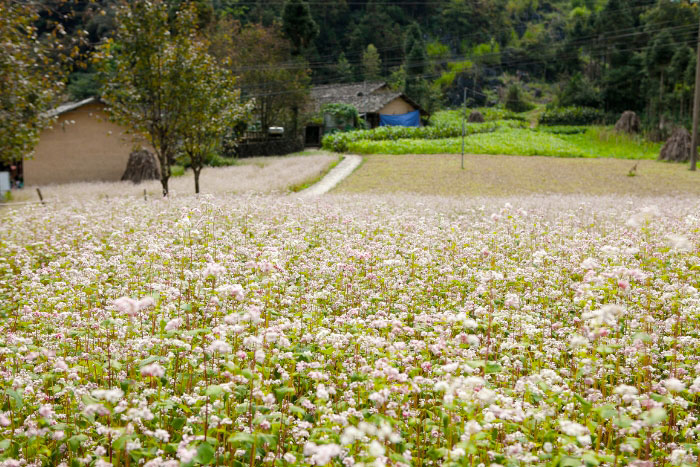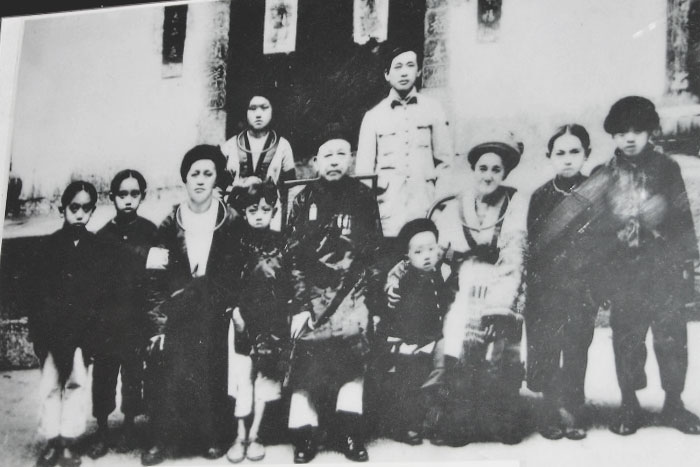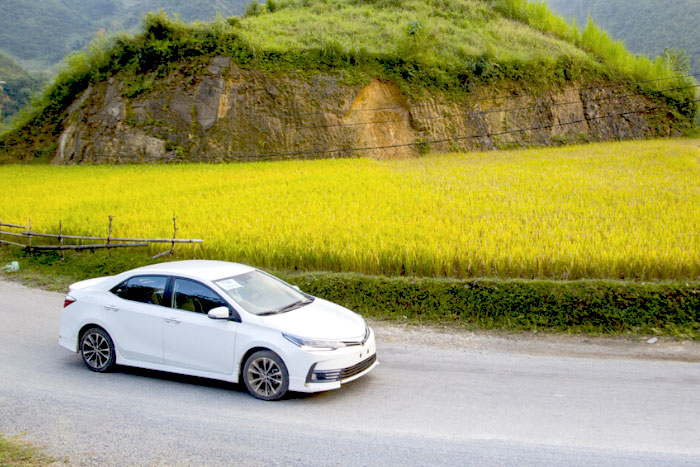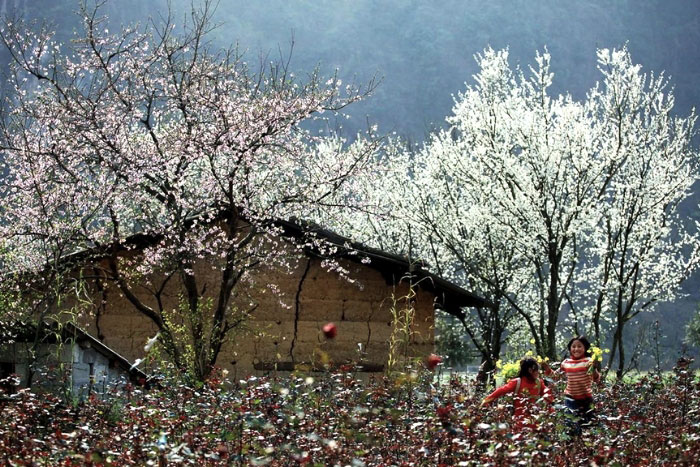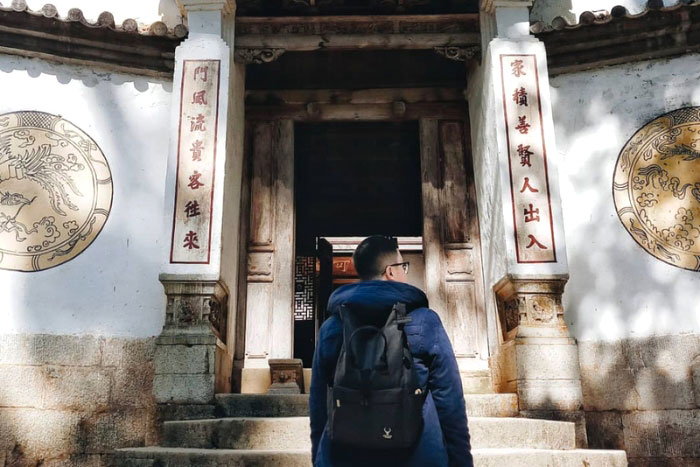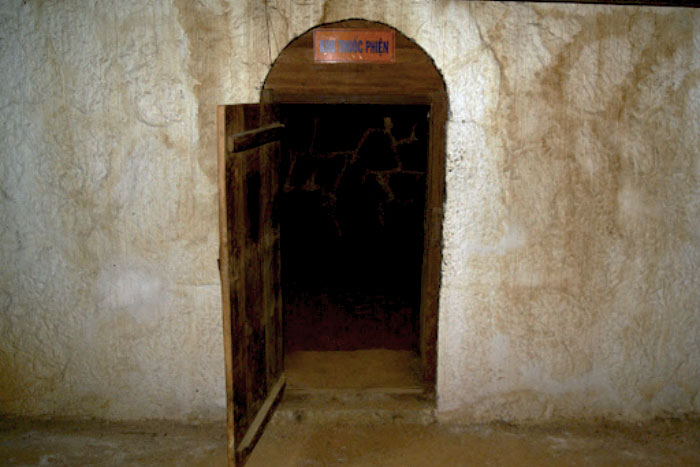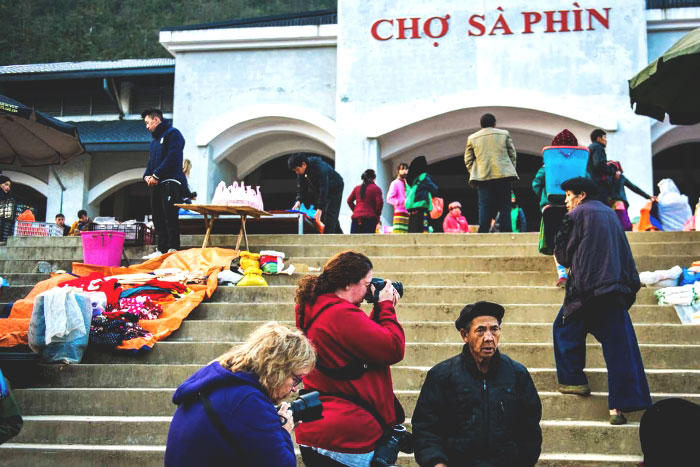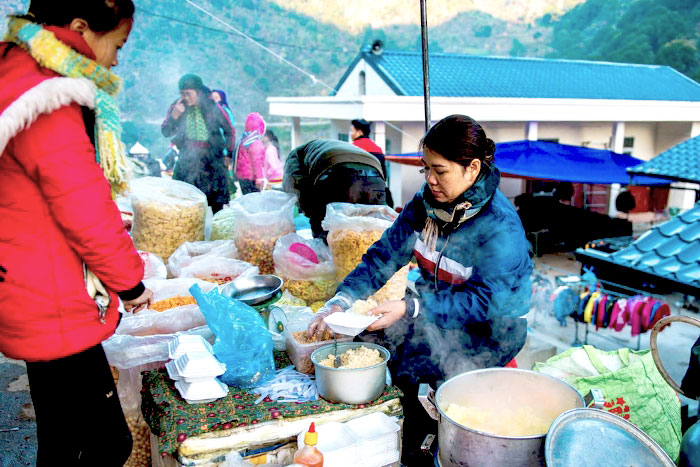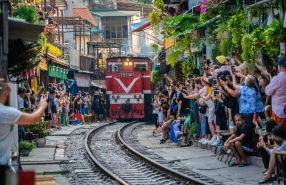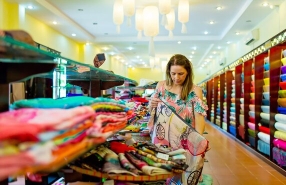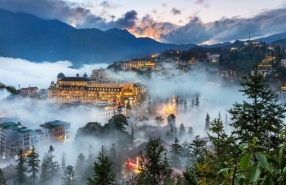Ha Giang Province is a land of rugged beauty and rich culture in the northernmost part of Vietnam. It is home to many ethnic minorities, such as the Hmong, who have preserved their traditions and customs for centuries. One of the most fascinating attractions in Ha Giang is the Hmong King's Palace, also known as the King Meo Palace (Dinh Vua Meo) or Vuong Family Palace. This palace was the residence of the kings of the Hmong people, who ruled over a large area of Ha Giang in the early 20th century. Join us on this exploration of the captivating allure of Ha Giang and the Hmong king's palace, where you can learn about the history and culture of this unique region and its people
I. Ha Giang - An attractive destination for explorers
1. Brief introduction to Ha Giang, Vietnam
Ha Giang is a mesmerizing province nestled in the northernmost part of Vietnam, bordering China, renowned for its breathtaking landscapes and rich cultural tapestry. With its rugged terrain, Ha Giang province boasts some of the most spectacular mountainous scenery in the country, featuring towering limestone peaks, deep valleys, and winding rivers that create a picturesque tableau.

The region is home to a diverse array of ethnic minority communities, each contributing to the vibrant cultural mosaic of Ha Giang. When traveling to Ha Giang, you will have the opportunity to immerse yourself in the traditions and customs of these communities, gaining insight into their unique way of life. The local markets, where colorful traditional attire is on display, offer a sensory feast and a chance to witness the bustling activity that defines daily life.
2. Ha Giang Wonders: Unveiling the Must-See Attractions
About 300 kilometers north of Hanoi, Ha Giang is a destination of stunning natural beauty, rich cultural diversity, and thrilling adventure. There are countless famous tourist attractions here that will take your breath away, such as Dong Van Karst Plateau, Ma Pi Leng Pass, Lung Cu Flag Tower, Hmong King's Palace, etc. These attractions showcase the diverse landscape, history, and culture of Ha Giang, where you can encounter ethnic minorities, such as the Hmong, the Tay, the Nung, and the Dao, who have preserved their traditions and customs for centuries.
It is also famous for its festivals, such as the Khau Vai Love Market, the Buckwheat Flower Festival, and the Fire Dancing Festival.
Whether you choose to explore Ha Giang by motorbike, car, or shuttle bus, you will be rewarded with unforgettable experiences and memories.
II. Hmong King Palace - A symbol of the history and culture of the Hmong people
1. Location, legend, and the process of building the Hmong King's Palace
Nestled in the picturesque Sa Phin Valley, in the remote province of Ha Giang, Vietnam, located about 125km from Ha Giang city center and 15 km from Dong Van, there is the Hmong King's Palace. This royal place is a magnificent structure; it was the residence of the kings of the Hmong ethnic group, Vuong Chinh Duc and Vuong Chi Thanh, who ruled a vast area encompassing four major districts in Hà Giang: Quan Ba, Yen Minh, Dong Van, and Meo Vac, during the French colonial era up until Vietnam regained independence in 1945.
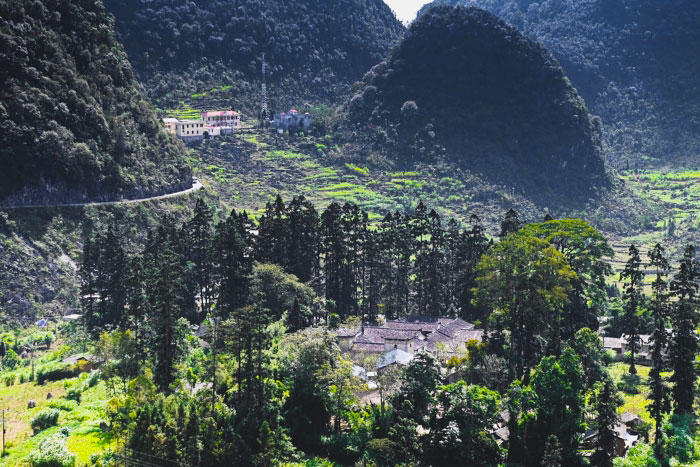
The process of building the Hmong King's Palace reflects the rich heritage of the Hmong people, and it unveils a captivating tale that resonates through the centuries. The palace was built in the late 19th century and completed in the early 20th century with the approval of the French colonial authorities, who recognized the Hmong kings as their allies. The palace was designed and built by a craftsman from Yunnan, China, with the assistance of the local H’Mong people. Together, they have created a stunning and captivating landscape, which is a blend of traditional Chinese, French, and Hmong architectural styles.
It is said that Vuong Duc Chinh spent over 150,000 Indochinese piasters on the construction of the palace, which was a huge sum of money at the time. The palace covers an area of 1,200 square meters within a total area of around 3,000 square meters and includes 64 rooms with four wings surrounding a central atrium. Every inch of the King Meo Palace carries the imprint of Hmong cultural identity. The architectural details, adorned with intricate carvings and traditional motifs, showcase the artistry of the Hmong people.
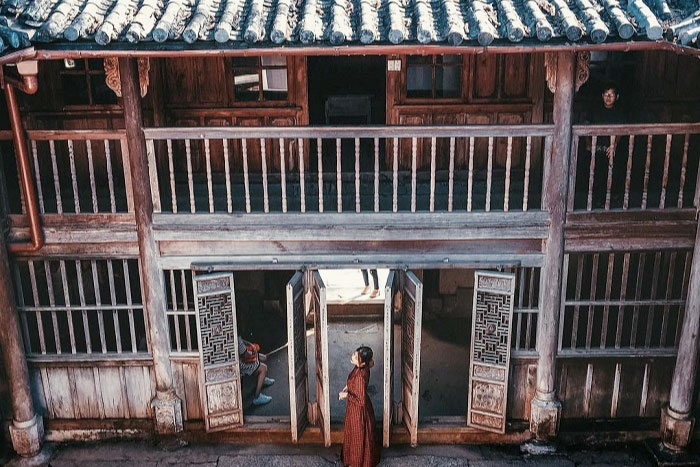
Besides, the prosperity and power of the Vuong family are also shown through the details on the two sides of the entrance, which are lines of majestic 100-year-old and cunninghamia trees, while the path is laced with large stone slabs. The palace is surrounded by a massive stone wall, which serves as a defense against enemy attacks. The expansive courtyards and gardens surrounding the palace evoke a sense of tranquility, inviting travelers to reflect on the historical significance of this royal enclave.
2. Whispers of the Past: Untold stories surrounding the palace of the Vuong Family
The Hmong King's Palace not only boasts impressive and grand architecture but is also surrounded by intriguing legends. One of the legends is about the original residence of the Hmong King of the Northeast, Vuong Duc Chinh. He lived in a large mountain pass but faced many difficulties and obstacles there. Therefore, he invited a talented feng shui master, Truong Chieu from China, to choose a location for his new house. After careful consideration, the master selected the Sa Phin Valley as the place to build the palace. He believed that the house located in the middle of a hill shaped like a turtle would bring prosperity and wealth to the whole family. Indeed, as the master predicted, the Vuong family became more and more prosperous afterward.
III. Discovering destiny - Time and route to reach the historical relics of the Hmong King
1. Transportation and route
To get to the Hmong King's Palace from Ha Giang, you can embark on a captivating journey through a variety of transportation modes and scenic routes. The road trip begins with the option of hiring a local guide who can guide you through the many picturesque landscapes of Ha Giang Province. Alternatively, one can opt for a self-driven adventure, renting a car or motorbike for a more personalized exploration.

Firstly, you need to choose a means of transport for your trip from Ha Giang to Dong Van town by bus, renting a car, or motorbike. The journey unfolds along winding roads that traverse the mesmerizing beauty of the northern mountains. As you ascend through the rugged terrain, you are treated to breathtaking views of terraced rice fields, ethnic minority villages, and the majestic peaks of the Dong Van Karst Plateau Geopark. From Dong Van town, drive along National Highway 4C (National Highway 4C) and turn left at the sign to King Meo Palace (Dinh Vua Meo).
If you choose to rent a private car and driver for 1,000,000 VND (43 USD), you will feel more comfortable and safer than taking the bus, but it may take longer due to traffic and road conditions. It takes about 10 to 12 hours to reach the royal palace by car.
And if you choose to ride a motorbike, you can rent one from Ha Giang City for about 200,000 VND per day and need to have a valid driver's license and a motorbike rental contract. After that, you can comfortably immerse yourself in the Ha Giang Loop tour through Quan Ba, Yen Minh, and Dong Van. This route is scenic but challenging, with many steep and winding roads. You should be careful and attentive when riding, especially in rainy or foggy weather. It takes about 8 to 10 hours to reach the mansion by motorbike.
2. The best time to explore the Vuong Family Palace
Nestled in the picturesque landscapes of Ha Giang, the Vuong Family Palace stands as a testament to Vietnam's rich cultural heritage. The Hmong King’s Palace is always open to visitors all year round (time opens from 7:00 a.m. to 5:00 p.m. every day), so any time you come here, you can visit this unique architectural work. To choose a suitable time to explore Ha Giang, you can refer to some useful information below, which will help you get an overview of how the beauty of this place changes according to the seasons.
The ideal time to visit the Ha Giang and Vuong Family Palace is from October to December when the weather is cool and dry and the surrounding landscapes burst into vibrant hues of golden yellow and deep red. The crisp air enhances the allure of the palace and its surroundings, creating a captivating atmosphere for exploration. You can enjoy the colorful flowers, the green rice terraces, and the majestic mountains.
Another advantage of visiting Ha Giang in autumn is that you can witness the harvest season when the rice fields turn golden yellow and the farmers celebrate their hard work. You can also join the local festivals and celebrations of ethnic minority groups, such as the Khau Vai Love Market and the Buckwheat Flower Festival.
However, Ha Giang province is beautiful all year round, and each season has its charm and attraction. You can visit Ha Giang in winter to see the snow-capped mountains and the peach blossoms, in spring to see the plum flowers and the green fields, or in summer to enjoy the fresh fruits and the cool streams
IV. Discovering Legacy: Unconventional Things to Do at Hmong King’s Palace
1. Admire and capture the impressive views of the architecture and interior of the King Meo Palace
a. The architecture
Every visitor to King Meo Palace is welcomed into a realm of awe-inspiring architectural grandeur and captivating interior design. As you step onto the grounds of this historical masterpiece, you are transported back in time, and your senses are immediately immersed in the rich cultural tapestry that defines the palace. However, remember that you need to buy a ticket at a common price for adults and children of 20,000 VND per person. You can comfortably visit the architecture as well as explore the unique cultural features inside the premises of this mansion.
Because the palace was built at the foot of a valley surrounded by highlands, the entire building was protected by dome-shaped mountains like turtle shells, providing excellent defense capabilities in fierce battles with enemies from outside. Not only that, around the Hmong King's Palace, there is also a sturdy rock wall which is 60cm in width, 2.5 meters high, and many guarding towers.
The exterior of the royal palace stands as a testament to the architectural brilliance of a bygone era. The palace consists of six two-storied houses with a total of 64 rooms, all connected, with green pebbles, pine woods, and terra-cotta tiles being the main building materials. It was carefully decorated with intricately carved images of sacred and respected animals such as lions, dragons, bats, and phoenixes.
In addition to the main rows of houses, for the king and the family members to rest and work in, there are also rows of houses for the servants, and storage rooms for food, drugs, weapons, and equipment as well.
The kitchen, water tanks, and stables are situated outside with a large garden with many different types of trees, including wood, pear, peach, and other varieties.
The Hmong King's Palace was designated as a national architectural and artistic relic by the Ministry of Culture, Sports, and Tourism in 1993, after nearly a century of existence. Furthermore, it took five years to commence its construction and restoration. Up to now, the mansion still retains its original appearance.
b. Interior
After more than a hundred years of existence, most of the mansion’s interior of the palace is still well-preserved as the first day, creating curiosity for anyone who comes to explore it at least once in their life.
Venturing inside, from the vantage points within the palace, you can admire panoramic views that extend to the lush landscapes beyond. Large windows and open verandas invite natural light, creating a warm and inviting ambiance that complements the palace's splendor. Photographers and enthusiasts alike find solace in the opportunity to capture the essence of King Meo Palace. The play of light and shadow against the architectural nuances provides a canvas for unforgettable photographs.
Feel free to immerse yourself and explore the Hmong King's Palace, which has now become a museum telling stories about the Hmong people and their culture. Each room is a treasure trove of cultural significance and artistic finesse. Ornate furnishings, meticulously crafted wooden panels, paintings, furniture with poppy plant-shaped decorations, and traditional Hmong motifs grace the chambers, transporting visitors to a time when craftsmanship was revered. The mansion’s interior is still preserved with many authentic antiquities, such as stone mortars, fireplaces, wooden tables, tools, and weapons.
2. Interact and learn about the culture of the Hmong people
Embarking on a journey to explore the Hmong King's Palace in Ha Giang is not merely a tourist expedition, it is an opportunity to engage with and delve into the rich cultural tapestry of the Hmong people. Beyond the architectural marvels and historical significance, you have the chance to interact closely with the local Hmong community, fostering a deeper understanding of their traditions and way of life when visiting Sa Phin Market.
The Sa Phin market is a small local market, located in Sa Phin district, right under the road leading to the King Meo Palace. If you travel by motorbike to the royal palace, you can park your bike at this market and walk to the palace. The parking fee is 5,000 VND/bike.
Here, you will see or try on colorful Hmong attire, participate in local dances, or even sample authentic Hmong cuisine. Such interactions foster a sense of connection and appreciation for the Hmong culture, creating lasting memories for you. You can also talk to them, listen to their stories, and ask them questions. Hmong ethnic people are usually friendly and hospitable, and they will appreciate your interest and respect.
And by interacting with and learning about the culture of the Hmong people, you will gain a deeper understanding and appreciation of their heritage and diversity.
V. Some tips useful for you when visiting the Hmong King's Palace
Dress Appropriately: Hmong culture places importance on modesty. Consider dressing respectfully, and if available, don traditional Hmong attire for a more authentic feel. Choose comfortable sports shoes for easier movement because the roads you traverse will often be difficult and rugged.
Ask Questions: Don't hesitate to ask questions about the artifacts, customs, and stories behind the palace. Locals are often eager to share their knowledge, providing you with a richer understanding of the cultural context.
Capture Memories Responsibly: While photography is encouraged, be mindful of cultural sensitivities. Ask for permission before photographing people, and avoid disrupting sacred or private spaces within the palace.
- Attend Cultural Demonstrations: Take advantage of any cultural demonstrations or performances happening on-site. These activities offer a unique chance to witness traditional Hmong practices, dances, and crafts.
In conclusion, exploring Ha Giang is not just a journey through breathtaking landscapes and vibrant cultures, but also an immersion into the rich historical tapestry of the region. The discovery of the Hmong King's Palace, the royal palace of the Vuong family, is a hidden gem nestled amidst the mountains, adding a layer of drama and mystery to the adventure. This remarkable destination not only captivates with its scenic beauty but also invites travelers to uncover the secrets and stories of the Hmong kings, creating an unforgettable chapter in the narrative of their Ha Giang exploration. So, don't hesitate to plan a perfect, exciting trip with us to Ha Giang province, where you can explore breathtaking landscapes, famous landmarks, diverse culture, and the heroic history of the northernmost part of the country. For the guide: 5 USD per person per day.
Contact Autour Asia - a travel agency in Vietnam to bring you memorable experiences on your holiday. You will discover the wonderful beauty of the country and people of Vietnam, from the blue beaches, and the majestic mountains, to the peaceful countryside, and the dynamic cities.




